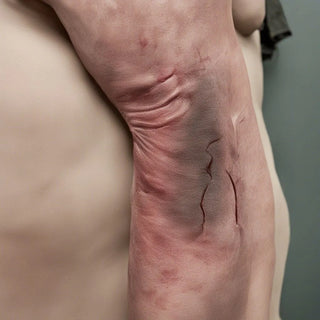In our last article, we took a broad look at the phases of wound healing - inflammation, proliferation, and remodeling. Now let's zoom in on the key cells that carry out these processes. When our skin is damaged, a range of specialized cells work together to repair the wound.
Clotting with Platelets
Platelets are the first responders after an injury. When a blood vessel is damaged, platelets rush to the scene and stick together to quickly form a clot. This plugs up the wound to stop bleeding. Platelets also release growth factors like PDGF to amplify the healing response.
Neutrophils - The Clean-Up Crew
Neutrophils are white blood cells that swarm into the wound within hours after injury. They act like the clean-up crew, ingesting and destroying any bacteria and cellular debris. Neutrophils kill microbes by releasing toxic enzymes and oxidants. They clear out the damaged tissue to prep the area for repairs.
Macrophages - The Foremen
Macrophages follow on the heels of neutrophils. They continue cleaning up any lingering bacteria and also secrete growth factors that support new tissue growth. Macrophages release cytokines like IL-1, IL-6, and TNF-α that stimulate cells involved in proliferative phase healing.
Fibroblasts - The Builders
Fibroblasts produce collagen and other extracellular matrix proteins that act as the scaffolding for new skin. They also pull together the wound edges via contraction. Signals from platelets and macrophages cause fibroblasts to proliferate rapidly and initiate synthesis of scar tissue matrix.
Epithelial Cells - The Resurfacers
Epithelial cells, like keratinocytes, migrate across the wound bed to restore the protective barrier function of the skin. They crawl forward, attaching to the wound matrix and dividing quickly to provide a new covering. This process is known as epithelialization.
So in summary, platelets, immune cells, fibroblasts, and epithelial cells all work as a team, playing vital roles during the complex choreography of wound repair.
Disclaimer: This article provides general information about skin healing and is not medical advice. Please consult a doctor for any skin concerns.
References
Gurtner, G. C., Werner, S., Barrandon, Y., & Longaker, M. T. (2008). Wound repair and regeneration. Nature, 453(7193), 314-321.
Guo, S., & DiPietro, L. A. (2010). Factors affecting wound healing. Journal of dental research, 89(3), 219-229.
Velnar, T., Bailey, T., & Smrkolj, V. (2009). The wound healing process: an overview of the cellular and molecular mechanisms. The Journal of International Medical Research, 37(5), 1528-1542.
Stay tuned for more insightful content on the role of nutrition in health and healing from Condition Directed Supplements.
